|
Artemy Lebedev
§ 80. In the President’s rearDecember 31, 2001 |
|
While on a national TV address, apart from words, the President has some other effective weapon tucked away at his behind—the backdrop. |
|
Few people remember what exactly is behind the President. You can see that as you watch, but unconsciously. The President changes the backdrop pretty often, which is quite natural: he doesn’t stay put. |
|
If it comes to a showdown, I’ve been keeping a close eye on the President for quite a while. Or things behind him, to be more precise. And I have to say that as far as backdrop furnishings are concerned, the US President beats ours to a pulp. Well, not the President in person, of course, but his team of stylists and consultants, which still says a helluva lot. |
|
Let us look at that from a historical perspective. This is how Leonid Brezhnev, the Soviet Union’s ruler in 1964–1982, delivered his speeches on TV. There is the USSR map in the background: |
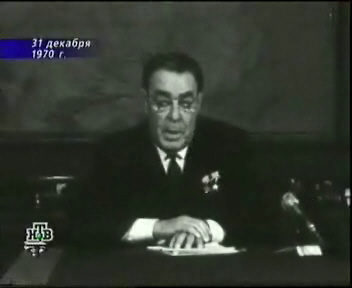 |
|
This is how Igor Kirillov, the Soviet and Russian TV old-timer, appeared on TV when Soviet rulers were not strong enough to rise from their sick beds and sit up before a video camera. Behind him there’s the Spasskaya Tower of the Moscow Kremlin supplemented by a chunk of the blue studio backdrop to prevent viewers from thinking that the anchorman is sitting on the Red Square and getting cold: |
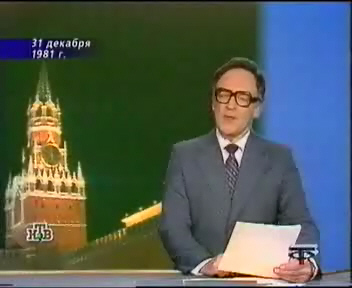 |
|
This is how Mikhail Gorbachev delivered his speeches. A no-frills scene, no clean-cut ideology in sight, everything should be heard in a voice. There’s a background in the background: |
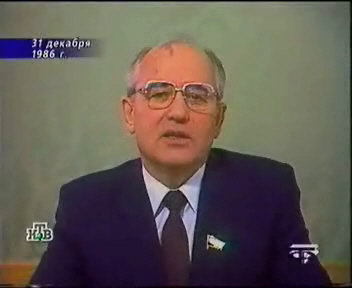 |
|
Let’s make a shortcut to the US President: |
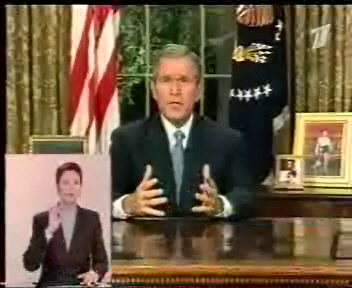 |
|
What we are seeing is George Bush tackling the tough issue of the war in Afghanistan. There are kids’ photos in gilded frames in the background (they are the ones the whole thing is about, America’s future—children are all we have). The curtains are almost drawn, the flags are put close to the President’s shoulders. The only gap is filled by George W. Bush (the window pane is to remind us that behind the President there’s a window out into the country). |
|
The President’s hands move so as to get across a message of something in between “it’s an honest-to-goodness truth, folks” and “I’ll strangle ye all”. And now the most important part—the “signal”, as it were. Since subliminal advertising is a fib and the 25th frame no longer works miracles, one has to get along with the remaining 24. Have a look at the blue U.S. Presidential flag with the coat of arms. It stands on Bush’s left hand. To fit the occasion of the war talk, the banner was turned so as to reveal the bald eagle’s leg (or arm?) clutching the bundle of 13 arrows denoting the power of war. When the American President talks about the system of national education, the eagle’s leg/arm holding an olive branch with 13 leaves signifying peace can always be seen in the frame. |
For a more detailed account of subliminal advertising, see § 94, paragraph 19 |
|
Now let’s return to our muttons. ’Scuse me, to backdrop consultants of our Presidents. This is how Boris Yeltsin was aired in 1995: |
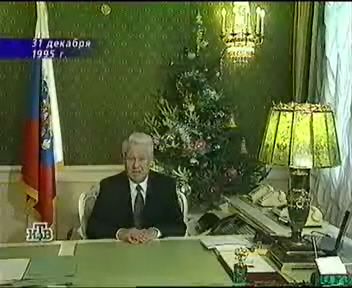 |
|
In the background there is green silk (or whatever) wallpaper, the Russian Federation President’s standard standing upright like a push broom wrapped with a rag, a one-sided Christmas tree (one of the sides had been cut off to make it lean flat against the wall), pin-up lamps, a variety of phones (will they ever procure a digital exchange with a single phone set?). There’s a slew of malachite stationery holders in front, a desk lamp. The President is sitting in a pose more befitting a non-achiever before a teachers’ council with hands crossed on top of the desk that’s a bit too tall. |
|
And this is how Boris Yeltsin appeared on TV in 1996: |
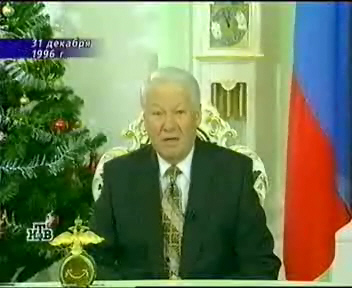 |
|
In the background there are a Christmas tree, a clock showing a time of five minutes to 12, a piece of the Russian Federation flag. The President’s tie matches the color composition of the arm chair back and the clock. In the foreground sits the symbol of state power displayed as a golden nut cracker with a smiley on the reverse side (the viewer is facing)—the President’s ink pot. |
|
This is how Boris Yeltsin appeared in 1999, uttering his famous words “I am leaving…”: |
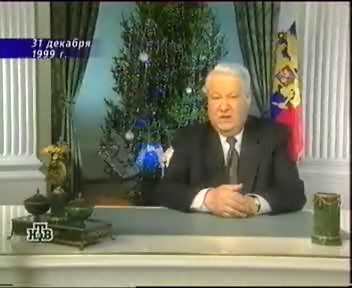 |
|
In the background there’s a Christmas tree in a recess enclosed in tucked-up curtains, two columns in a vague classical style. For some unknown reason, the flag (more precisely, the Russian President’s flag) is standing on the left hand. When there’s one flag, it’s better to put it on the right hand side. On the flag a piece of the eagle’s right leg, the Moscow coat of arms and the left head can be seen—you are free to construe that the way you like. In the foreground on the right a whole ink pot is visible (“I am leaving. See what an ink pot I used to have”); on the left there’s a pencil cup (“I am leaving—run out of pens”). Dark green hues, Yeltsin’s traditional palette, prevail. There is no clock; the watch on the President’s wrist is too far to say what time it is. |
|
And this is the way Vladimir Putin appeared immediately after Boris Yeltsin: |
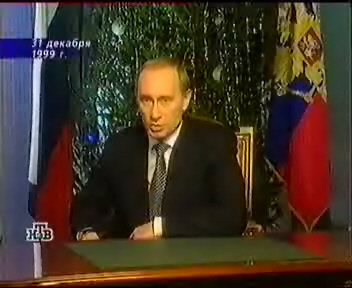 |
|
In the background there’s a Christmas tree (mark you, the one Yeltsin left behind). The flags are properly arranged: the Russian flag on the right hand side, the Presidential flag on the left hand side. On the Presidential flag the eagle’s talons are clutching the scepter. The scepter is broken by a crease, but it’s still a scepter, not a piece of it. The desk is empty (just taken office, not been given the pencil cup yet). Keeping his hands under the desk, seated half-turned (which means: got something to hide, not confident enough). |
|
And here’s Vladimir Putin’s address on the occasion of the 60th anniversary of the beginning of the Great Patriotic War (1941–1945): |
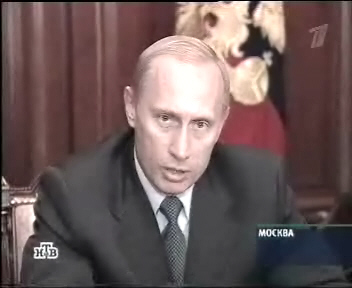 |
|
One of the first cases when the flag is positioned in a more or less acceptable fashion. The camera man stands real bad, but that’s an error to be rectified by another authority. The ball is in the eagle’s talons. Overall atmosphere is let’s-get-down-to-work. |
|
Now we’ll take a look at the both coats of arms—the Russian and the American—and try to understand what sort of a problem our stylists are having to deal with. |
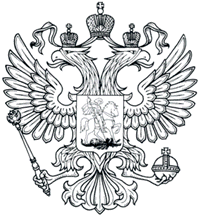 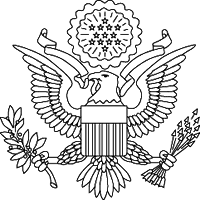
|
|
The U.S. coat of arms is profoundly symbolic and elaborate. It’s got 13 of everything—stars, stripes, arrows, leaves, olives among leaves and even letters in the motto “E pluribus unum”. The eagle is holding the symbols of war and peace—a very ingenious selection of symbols. The eagle faces its own right, which is a direction quite natural for the authorities. |
|
The eagle in the Russian coat of arms is having problems: it’s schizophrenic. First, it looks both ways. Second, it’s got the second coat of arms on its chest: Moscow’s St. George. Third, it’s holding two items in its talons: the scepter and the ball. It would be quite all right, but for both of them being the symbols of power. So there’s no knowing which of them ought to be used. Moreover, there’s another double-headed eagle at the pinnacle of the scepter. And the coat of arms repeats itself ad infinitum, like a Mandelbrod set. |
|
Hopefully the royal heraldry specialists and image makers will eventually get the matter sorted out. At the image where President Putin speaks on the occasion of the 60th anniversary of the Great Patriotic War, the eagle is turned to reveal the ball—obviously an attempt to re-think this symbol of royal power as a globe. Substituting the scepter with a Kalashnikov assault rifle will marvelously round off the coat of arms. |
|
I think there are two ways. The first way is interring this coat of arms due to its incongruity with the current state regime (there’s no tsar, is there?). The second one is drawing a new coat of arms, leaving the eagle’s two-headedness as a symbol of union of the East and West (a popular interpretation); discarding the knick-knackery in the form of crowns, crosses, sticks and balls; and finally, covering these direful knees with feathers. |
|
When these niceties become at least a subject of discussion by folks in charge of the President’s outward looks, we’ll no longer have a chance to get a glimpse of the President performing as Santa’s Little Helper: |
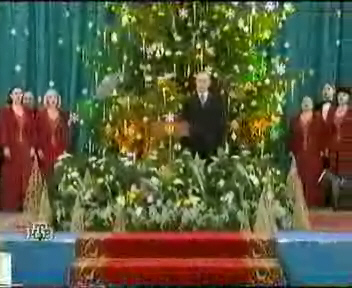 |
|
|
|